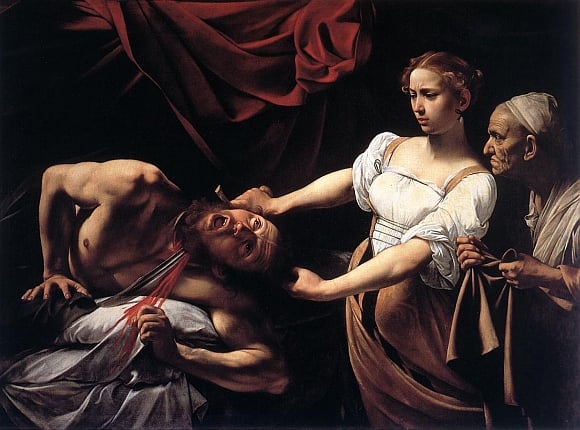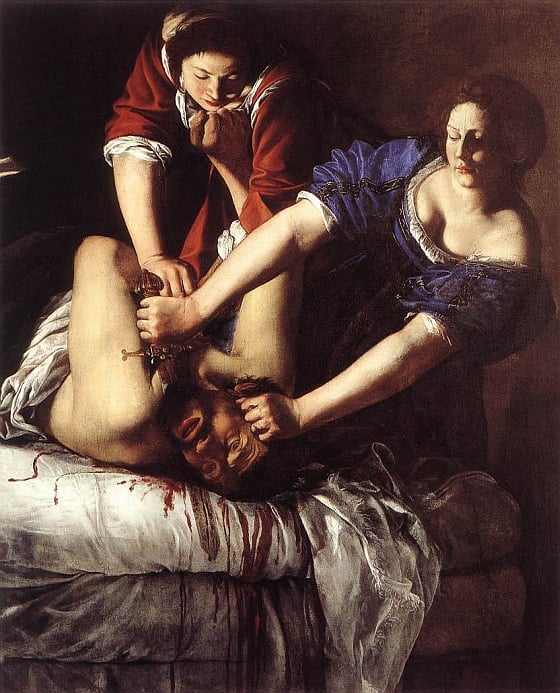
Cuelga sangriento de la cama al suelo
el hombro diestro del feroz tirano,
que opuesto al muro de Betulia en vano,
despidió contra sí rayos al cielo.
Revuelto con el ansia el rojo velo
del pabellón a la siniestra mano,
descubre el espectáculo inhumano
del tronco horrible, convertido en hielo.
Vertido Baco, el fuerte arnés afea
los vasos y la mesa derribada,
duermen las guardas, que tan mal emplea;
Y sobre la muralla coronada
del pueblo de Israel, la casta hebrea
con la cabeza resplandece armada.
From bed to floor dangles
the bloodied right shoulder of the ferocious tyrant,
who vainly stormed the wall of Bethulia,
hurling bolts towards the heavens but against himself.
In agony enshrouded, the red veil
of the pavilion, on the left side,
reveals the inhuman spectacle
of his hideous torso, now rendered in ice.
Bacchus’s residue stains his mighty armor,
the glasses and the table overturned;
the guards who failed him slumber;
And there, crowning the wall
of the people of Israel, the Hebrew woman
appears pure, resplendently armed with his head.
–Félix Lope de Vega y Carpio, Al triunfo de Judit in Rimas humanas y divinas del licenciado Tomé de Burguillos (1634), lxxviii (S.H. transl.)
The triumphant Judith is one of the most beloved images of the transition period from Renaissance to Baroque. In fact, if we had to pick one iconic figure for the early Baroque, I would pass on the bevy of archangels and would go for the triumphant Judith. I’d pick it precisely because it is gently subversive, wielding Biblical imagery to send a message not at all to the taste of the secular or religious hierarchy of the age. There is something revolutionary about that smiling, radiant woman holding the head of a general, her lover, atop the battlements.
This poem by Lope de Vega is a very striking example. It seems that he is describing a painting, or actually, two paintings. But it is difficult to identify in the large repertoire of Judith paintings of this era just which ones. Could it be the Caravaggio? The image he choses of Bacchus (a jarring reference, not, after all, present in the Bible!) would point naturally to the man who built his reputation on a painting of Bacchus. But then there are hints of Michelangelo, of Donatello, of the multiple efforts of Gentileschi in his words. I don’t know whether Lope de Vega saw these paintings, but it’s hard to doubt that he was familiar with the images they portrayed, and the ties of the Latin Mediterranean world at this point were strong. Spain was at its political apogee, and was a dominating force across the Italian peninsula. And it is fair to say that Lope approaches his poetic theme like a painter approaches his canvas, with the same esthetic sensitivities.
A modern English speaker would gloss over that word “triumph,” would view it as a synonym for victory. But that would be a mistake. In the Renaissance, the concept of the “triumph” was revived from the classics and was very popular. Last week I quoted, for instance, from Bruno’s Spaccio della bestia trionfante, a typical use. In Bruno’s important work fortezza does battle for the position of Hercules among the gods and the theme is carried with a series of dialogues that directly reference the culture and thought of Bruno’s own age. The work is allegorical, implying a contest between the Renaissance concepts of fortuna and fortezza, which might be rendered in English (though problematically) as fate and valor. The passage I took, one of the highpoints of the work, hammers this home. These allegories and images are important, it tells us. They help us understand our world and the forces that drive it. But we must take care not to be beholden to them. Writers like Bruno used the term “triumph” in the sense of classical antiquity–it was a formal festivity in which a conquering hero was saluted as the trophies of his martial successes were produced before a crowd.
Lope de Vega uses the word triunfo in this classical sense. He puts Judith through steps which mimic the old triumph. In the late Republican age, a general granted a triumph would be paraded through Rome in a ceremonial chariot, often drawn by slaves. His face would be painted red. In his hand he would hold aloft a laurel wreath, while a figure representing the goddess (of fortune or victory) would hold another laurel wreath over his head. Behind the chariot would trail the vanquished foe and booty of war. Note how Lope de Vega evokes these images with the red stained face of Holofernes, the trophy armor enshrouding his torso, the severed head of the slain general held aloft from the walls. He has rendered the event as a triumph.
Why is this image of Judith so powerful, so often evoked? Why does it appeal to Lope de Vega? The Baroque of course loves grandiose theatrality, and in the whole Biblical literature there is little which comes close to the story of Judith and Holofernes for shocking drama. It appeals in other ways, too. As this poem and the notion of Judith in Triumph examplify, it was a perfect vehicle for fusing classical and Biblical traditions. It presents an unlikely hero. It is filled with the language of mutilation and pain–the severed torso, the bloodstained armor, the element of agony–again favored themes of the period. But there are some things particular to the Judith story. There is a strong political moment. Note that Lope uses the words feroz tirano, fierce tyrant. Holofernes, an Assyrian general, attempts to subjugate a Jewish city, which falls to his advances before he falls to the sexual intrigues of Judith. One subtext of this image throughout the period was the righteous vanquishing a tyrannical foe.
There is also a clear sexual element. In Caravaggio and Gentileschi the eroticism is unmistakable. Judith used her sexual wiles as a lure in her battle with Holofernes. In social thought of this era, of course, the process of sexual solicitation was to be driven by males, and the alpha-male warrior was supposed to be dominant in this process. But here we see a divinely guided subversion of these principles.
Judith is not a virgin of course. In the Biblical text she is presented as a widow who has led a chaste life after her husband’s death. Her seduction of Holofernes is not detailed. Interestingly, Lope does not refer to Judith by the idiomatic Spanish judía, echoing her name and pointing to its etymology; rather he calls her by the Latinate hebrea. She is described as “chaste” or “pure,” a word that Lope echoes (casta). But what, exactly, is meant by that? This is an element of studied ambiguity, one of the elements of the story that made it so wildly appealing. Writing the same year as Lope, Martin Opitz–also captivated by the image of Judith and its dramatic potential–said this about Judith’s character: “she retains her chastity through the grace of God, a grace granted through deceit, for her acts of enticement and her words of solicitation go far beyond whatever can be considered seemly in a woman.” Normal moral measures have been inverted; Judith has been liberated from the sexual taboos normally imposed. God has ordained this. Was she really chaste or did she pursue things further with Holofernes? The text allows erotic suggestion.
Is this Judith then to be seen as a liberated woman, even if only for a limited purpose and a fleeting moment? Or is she to be seen as a woman forced to prostitute herself for the gain of her community? And, as Brecht asked, what happened after the heroic act? Was she tormented for having flouted sexual convention? This issue complex is encountered most dramatically in the works of Artemisia Gentileschi. I saw these works for the first time at the 2001 exhibition the Metropolitan Museum of Art mounted of the works of Artemisia and her father Orazio, two great masters of the late Renaissance/early Baroque whose works had been nearly forgotten. They are extremely powerful. They present a sexually empowered woman in bloody dominance over a virile warrior. We know from the surviving accounts of Artemisia’s rape trial, which dragged over more than half a year, that the cartoons for Judith, when discovered and presented to the tribunal, produced a sensation. Artemisia was attacked for breaking a series of taboos, starting with the depiction of a male nude by a woman. But what evoked the greatest sensation was her presentation of a sensual woman in triumph over a man.

So what drew the likes of Lope, Caravaggio, Michelangelo and Gentileschi to the story of Judith? Each gives us a subtly different series of images. But one thing unites them. These artists are all “outsiders” in some measure, creative geniuses who felt a measure of disdain or contempt for the social and sexual mores of their times. Judith offered the perfect vehicle for puncturing these mores–for demonstrating that they are not universal, and that God must in fact be indulgent of some sexual conduct which strays from the mold. Judith, after all, is a heroine. And God rewards those, like her, who strike a violent blow against the tyrant. The triumphant Judith is thus a figure of personal self-liberation.
Listen to mezzosoprano Gloria Banditelli perform the aria In somno profundo from Antonio Vivaldi’s oratorio Juditha Triumphans (1716)


